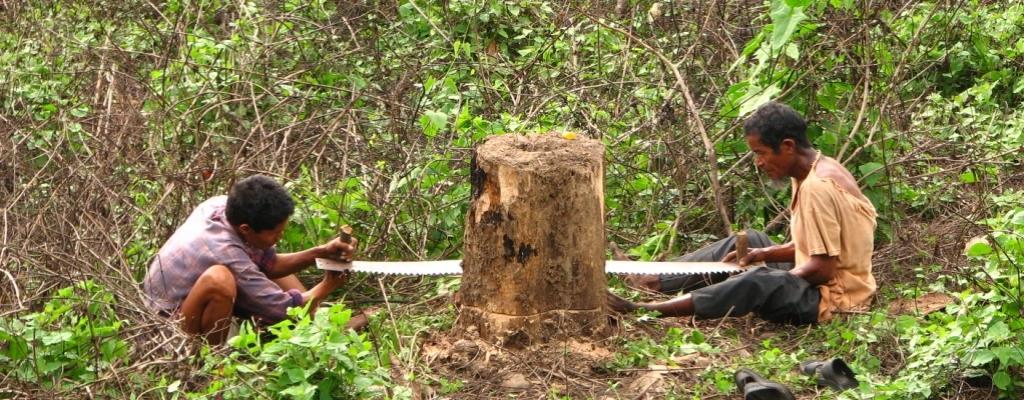

Scientific evidence shows that the felling of tropical forests creates ideal conditions for the spread of diseases



In the middle of this pandemic, we all recently celebrated the 50th anniversary of World Earth Day that symbolises support for environment protection. Although this is perhaps the first time we are not taking nature for granted, this pandemic surely raises questions about how we impact our planet.
The World Health Organization (WHO) on March 11, 2020, upgraded the status of the novle coronavirus disease (COVID-19) outbreak from epidemic to pandemic. Calling it as a pandemic is an acknowledgement of its global spread.
The coronavirus, named for the protein protrusions that decorate the outside of the virus like a crown, is actually a zoonotic disease – meaning it is passed from animals to humans. Other zoonotic diseases include the Severe Acute Respiratory Syndrome (SARS), Middle East Respiratory Syndrome (MERS), Ebola and bird flu.
WHO opines that bats could be the most probable carrier of COVID-19 but believes that the virus jumped to humans from another intermediate animal host, either a domestic or a wild animal.
Unprecedented destruction of the environment by human activities has increased the frequency of zoonotic diseases. According to UNEP’s Frontiers 2016 Report on Emerging Issues of Environment Concern, zoonoses are a threat to economic development, animal and human well-being, and ecosystem integrity.
Zoonotic diseases are ranked among the world’s most ill-reputed. For example, HIV, Ebola, and H5N1 influenza, all started in wildlife before close interactions with humans spawned their international outbreaks.
According to Chinese geologists, Wuhan, the capital of central China's Hubei Province, was a lush tropical forest millions of years ago. This fact raises a serious question: is it possible that deforestation could have triggered this new virus pandemic?
For a zillion ecological reasons, the loss of forests can act as an incubator for serious human health problem.
A research paper published in the Journal of Emerging Infectious Diseases hypothesised deforestation and associated environmental and population changes as the main drivers of zoonotic malaria species Plasmodium knowlesi becoming the main cause of human malaria in Malaysian Borneo.
Throughout human history, pathogens have emerged from forests. The Zika virus, that was believed to be causing microencephaly in newborns in Latin America, emerged from the Zika forest of Uganda in the 1940s.
It is pertinent to mention that the ecology of the viruses in deforested areas is different. Once forests are cut down, edges get established between deforested areas and forest.
In fact, a mosquito called Aedes africanus that is the host of the yellow fever and Chikungunya viruses, habitually lives on this edge and bites people working or living nearby.
Scientific evidence shows that the felling of tropical forests creates ideal conditions for the spread of diseases. Primates and other animals are also spreading disease from cleared forests to people.
A study published by Nature in 2008 identified 335 diseases that emerged between 1960 and 2004, at least 60 per cent of which came from animals. As such, one may blame bats or fishes for being possible sources of coronavirus, but humans are equally, if not more, to blame for the spread of this disease that is changing daily life across the globe.
Should the wildlife habitat destruction continue, the crowding of species will take place and their frequency of coming in contact with other different animals and humans will only increase.
Therefore, it is time we humans understand that nature poses threats and it is human activities that do the tangible harm by making health risks in a natural environment much worse by interfering with it.
In addition to doing everything we as global citizens can do to contain and extinguish the outbreak of coronavirus; Once the pandemic is contained, we must sit and relook our growth strategies.
Another aspect that needs to be given due respect is that public health research should learn from this pandemic and start considering the link between humans and surrounding natural ecosystems health. We ought to know what viruses the world might be up against in the future as they come out of the forest and how these viruses might spread and to potentially develop vaccines.
Ashutosh Senger is a practicing advocate and a patent agent based in New Delhi. Views expressed are the author's own and don't necessarily reflect those of Down To Earth
We are a voice to you; you have been a support to us. Together we build journalism that is independent, credible and fearless. You can further help us by making a donation. This will mean a lot for our ability to bring you news, perspectives and analysis from the ground so that we can make change together.

Comments are moderated and will be published only after the site moderator’s approval. Please use a genuine email ID and provide your name. Selected comments may also be used in the ‘Letters’ section of the Down To Earth print edition.